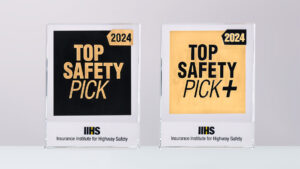IIHS Announces Top Safety Pick Award Winners for 2024
The new standards are more stringent than ever, but 71 models qualified for the 2024 awards...
The Insurance Institute for Highway Safety is making it harder to earn its TOP SAFETY PICK and TOP SAFETY PICK+ awards in 2024, challenging manufacturers to offer better protection for back seat passengers and improve their pedestrian crash avoidance systems.
Despite the stringent requirements, 71 models qualify for 2024 awards. Of those, 22 models earn TOP SAFETY PICK+, and 49 earn TOP SAFETY PICK.
“We followed the requirements we introduced last year with another major update in 2024,” said IIHS President David Harkey. “This year’s winners are standouts, offering the highest level of protection for both vehicle occupants and other road users.”
Last year’s biggest change was the replacement of the original side crash test with an updated version that uses a heavier barrier traveling at a higher speed. Initially, an acceptable or good rating was enough to garner the lower-tier TOP SAFETY PICK award. In 2024, a good rating is required for either TOP SAFETY PICK or TOP SAFETY PICK+.

Vehicles now need an acceptable or good rating in a revised version of the pedestrian front crash prevention to qualify for either award. The new version replaces the earlier daytime and nighttime tests with a single evaluation that includes test runs in daylight and some in the dark. Last year, vehicles could earn the lower-tier award regardless of whether they could avoid pedestrians in the dark.
In an even bigger change, the updated moderate front overlap test has replaced the original evaluation in the 2024 TOP SAFETY PICK+ requirements. Vehicles now need an acceptable or good rating in the evaluation, which adds a second dummy seated behind the driver and emphasizes back seat safety. A good rating in the original moderate overlap test is needed for the base TOP SAFETY PICK award.
To earn either award, a vehicle must offer good protection in a small overlap front crash, in which 25% of the vehicle’s width on either side collides with another vehicle or a stationary object. This year, the driver-side and passenger-side evaluations have been combined into a single rating. The test is performed on both the driver and passenger sides, and the rating is equivalent to the lower result.
Award winners also must have good or acceptable headlights equipped on all trim levels.
Hyundai Motor Group, which includes the Genesis, Hyundai and Kia, has the most 2024 awards overall — six TOP SAFETY PICK+ and 10 TOP SAFETY PICK awards for a total of 16. Toyota Motor Corp., which includes Toyota & Lexus, has the next highest total with one TOP SAFETY PICK+ and 12 TOP SAFETY PICK awards. Mazda earns the most TOP SAFETY PICK+ awards of any single brand, with five, and one TOP SAFETY PICK.
By class, small SUVs, midsize SUVs and midsize luxury SUVs are tied for the most TOP SAFETY PICK+ awards, with five each. Midsize luxury SUVs, which qualify for an additional 12 TOP SAFETY PICK awards, earn the most awards overall.
Relatively few cars and pickups qualify for either award.
“The high number of SUVs reflects the dominance of those vehicles in the U.S. market,” said Harkey. “It’s disappointing that only four pickups and four midsize cars earn awards, considering the popularity of those classes.”
IIHS introduced the original moderate overlap front test in 1995. At the time, most vehicles earned ratings of poor or marginal. For the past decade, virtually every vehicle tested has earned a good rating thanks to stronger vehicle structures, the introduction of front and side-curtain airbags and improvements in seat belt technology.
An analysis of 14 years’ worth of crash data involving IIHS-rated vehicles shows that a driver of a model rated good in the original moderate overlap test is 46% less likely to die in a head-on crash with a similar vehicle, compared with a driver of a model rated poor.
IIHS introduced the updated test to encourage similar advancements in the back seat. In today’s vehicles, there is barely any deformation of the occupant compartment in the moderate overlap test. In addition, automakers have added airbags and advanced seat belts in the front seats but not often in the rear. As a result, vehicles from model year 2007 onward, the risk of a fatal injury is higher for belted occupants in the rear seat than in the front.
To spur automakers to address that gap, the updated test includes an additional dummy positioned in the second row behind the driver and utilizes new metrics that focus on the injuries most frequently seen in rear-seat occupants.
In 2019, when IIHS launched the daytime vehicle-to-pedestrian evaluation, only 21% of the vehicles tested earned the highest rating of superior, while 44% of new models didn’t even offer the technology. By 2023, 59% of vehicles earned superior ratings in the daytime test, and 40% also earned superior ratings in the nighttime evaluation.
An advanced or superior rating in the daytime test was required for a 2023 TOP SAFETY PICK award, and an advanced or superior rating in the nighttime test was necessary to earn the “plus.” For 2024, IIHS has combined the two tests into a single evaluation, making nighttime performance essential for either award. The superior/advanced/basic/no credit scale has been replaced by the good/acceptable/marginal/poor scale used for other IIHS evaluations.
Pedestrians represent an increasingly large share of crash deaths, and pedestrian fatalities are currently at their highest level since the early 1980s. Most pedestrian crashes occur during the day, but three-quarters of fatal pedestrian crashes happen at night.
“There’s still progress to be made in the protection that vehicles provide for their occupants, as the introduction of the updated moderate overlap test shows,” Harkey said. “But many of the biggest gains will come from automakers and policymakers, along with car buyers and drivers, taking steps to protect everyone on the road, not just our own families.”
Click here for the full list of winners. For details on each vehicle, go to iihs.org/ratings.



